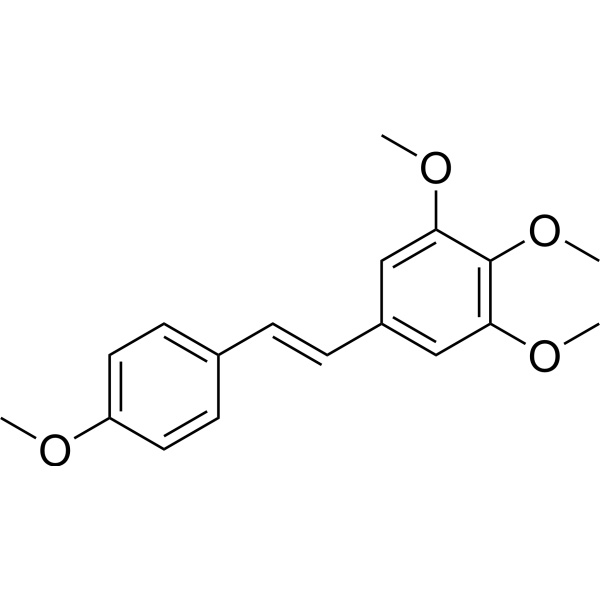Physicochemical Properties
| Molecular Formula | C18H20O4 |
| Molecular Weight | 300.35 |
| Exact Mass | 300.136 |
| CAS # | 134029-62-2 |
| PubChem CID | 5388065 |
| Appearance | White to off-white solid powder |
| Density | 1.1±0.1 g/cm3 |
| Boiling Point | 444.0±40.0 °C at 760 mmHg |
| Flash Point | 144.1±34.2 °C |
| Vapour Pressure | 0.0±1.0 mmHg at 25°C |
| Index of Refraction | 1.588 |
| LogP | 4.37 |
| Hydrogen Bond Donor Count | 0 |
| Hydrogen Bond Acceptor Count | 4 |
| Rotatable Bond Count | 6 |
| Heavy Atom Count | 22 |
| Complexity | 322 |
| Defined Atom Stereocenter Count | 0 |
| SMILES | COC1=CC=C(C=C1)/C=C/C2=CC(=C(C(=C2)OC)OC)OC |
| InChi Key | GGFQQRXTLIJXNY-AATRIKPKSA-N |
| InChi Code | InChI=1S/C18H20O4/c1-19-15-9-7-13(8-10-15)5-6-14-11-16(20-2)18(22-4)17(12-14)21-3/h5-12H,1-4H3/b6-5+ |
| Chemical Name | 1,2,3-trimethoxy-5-[(E)-2-(4-methoxyphenyl)ethenyl]benzene |
| HS Tariff Code | 2934.99.9001 |
| Storage |
Powder-20°C 3 years 4°C 2 years In solvent -80°C 6 months -20°C 1 month |
| Shipping Condition | Room temperature (This product is stable at ambient temperature for a few days during ordinary shipping and time spent in Customs) |
Biological Activity
| ln Vitro | DMU-212 (0.3125-40 μM) prevents human melanoma cells A375, MeWo, Bro, and M5 from growing [1]. In A375 cells, DMU-212 (30–50 μM; 24 hours) causes apoptosis, ERK activation, and the overexpression of cell cycle inhibitors [1]. |
| ln Vivo | In human ovarian cancer xenograft models, DMU-212 (50 mg/kg; ig; three times weekly; for 14 days) inhibits the growth of tumors [2]. |
| Cell Assay |
Cell Proliferation Assay[1] Cell Types: A375 cells, MeWo cells, M5 cells, Bro cells Tested Concentrations: 0.3125 μM, 0,625 μM, 1.25 μM, 2.5 μM, 5 μM, 10 μM, 20 μM, 40 μM Incubation Duration: 96 hrs (hours) Experimental Results: Inhibited the cellular proliferation of human melanoma cells at submicromolar or micromolar concentrations (IC50=0.5 μM for A375 and Bro and IC50= 1.25 μM for MeWo and M5 cells). Cell Cycle Analysis[1] Cell Types: A375 cells Tested Concentrations: 20 μM, 30 μM, 50 μM Incubation Duration: 24 hrs (hours) Experimental Results: Caused a marked increase in the levels of p21, p53 and cyclin B1 proteins with a concomitant decrease in the levels of cyclin A2. Western Blot Analysis[1] Cell Types: A375 cells Tested Concentrations: 20 μM, 30 μM, 50 μM Incubation Duration: 24 hrs (hours) Experimental Results: Significant upregulated Bax, caspase 3 and caspase 9 protein levels, while diminished the levels of the anti-apoptotic protein Bcl-2. Apoptosis Analysis[1] Cell Types: A375 cells Tested Concentrations: 10 μM, 20 μM Incubation Duration: 24 hrs (hours), 36 hrs (hours) Experimental Results: Induced apoptosi |
| Animal Protocol |
Animal/Disease Models: 6-weeks-old SCID female mice (20-24 g), with ovarian cancer xenografts[2] Doses: 50 mg/kg Route of Administration: po (oral gavage), three times a week, for 14 days Experimental Results: Lowered tumor burden. |
| References |
[1]. Activation of ERK1/2 is required for the antimitotic activity of the resveratrol analogue 3,4,5,4'-tetramethoxystilbene (DMU-212) in human melanoma cells. Exp Dermatol. 2015 Aug;24(8):632-4. [2]. DMU-212 inhibits tumor growth in xenograft model of human ovarian cancer. Biomed Pharmacother. 2014 May;68(4):397-400. |
Solubility Data
| Solubility (In Vitro) | DMSO : 20 mg/mL (66.59 mM) |
| Solubility (In Vivo) |
Solubility in Formulation 1: ≥ 2 mg/mL (6.66 mM) (saturation unknown) in 10% DMSO + 90% Corn Oil (add these co-solvents sequentially from left to right, and one by one), clear solution. For example, if 1 mL of working solution is to be prepared, you can add 100 μL of 20.0 mg/mL clear DMSO stock solution to 900 μL of corn oil and mix evenly. (Please use freshly prepared in vivo formulations for optimal results.) |
| Preparing Stock Solutions | 1 mg | 5 mg | 10 mg | |
| 1 mM | 3.3294 mL | 16.6472 mL | 33.2945 mL | |
| 5 mM | 0.6659 mL | 3.3294 mL | 6.6589 mL | |
| 10 mM | 0.3329 mL | 1.6647 mL | 3.3294 mL |
